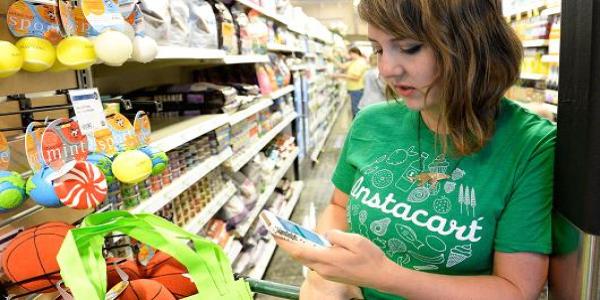For years, customers of the Whole Foods store on Ocean Avenue in San Francisco’s Ingleside district were greeted by a familiar sight: professional shoppers from the Instacart Inc. grocery delivery business combing the aisles. After selecting groceries for online customers, they would stage the finished bags in a spacious room on the store’s lower level, where the completed orders were picked up for home delivery.
Two weeks ago, a new crew of professional shoppers showed up at the store. Wearing no logos or other identifying marks, they used a different app to pick out orders. About a dozen of the newcomers commandeered the room downstairs, ringing up orders and sorting bags of groceries using newly installed fridges and shelves.
Instacart’s people were shunted to a corridor upstairs. Squeezed in between a staircase and the store’s cafe, they tried to do their jobs while pondering a new reality: Less than a year after acquiring Whole Foods for $13.7 billion, Amazon.com Inc. had begun muscling aside their employer.
“Instacart is now upstairs in a corner,” says Jennell Lévêque, who has picked and packed groceries as a contractor for the startup almost since its inception five years ago and has worked at the Ocean Avenue store. “I would feel stomped on.”
In 2014, Instacart landed Whole Foods as its first national partner. Customers used the Instacart app to select Whole Foods groceries for delivery to their homes. Under the partnership, Instacart got its own cashiers and staging areas at the upscale grocer’s stores. In 2016, the relationship deepened when Whole Foods bought an equity stake in Instacart and signed a five-year contract to make the startup the exclusive delivery provider for most of its merchandise.
When Amazon bought Whole Foods last year, it was widely assumed that the e-commerce giant would begin delivering Whole Foods groceries itself. Last month, Amazon announced it would begin offering free two-hour delivery from Whole Foods stores in Dallas and Austin, Texas; Virginia Beach, Virginia, and Cincinnati. On Tuesday, Amazon said the service is expanding to San Francisco and Atlanta.
All of which puts Instacart in an awkward spot. The San Francisco-based company champions itself as an alternative for brick-and-mortar retailers girding against the threat of Amazon, but now Whole Foods, Instacart’s partner and investor, is a subsidiary of its biggest rival. Instacart shoppers are working side by side with their potential replacements. At another Whole Foods in San Francisco located on Market Street, Amazon workers set up four checkout stations and several industrial fridges in an area near the entrance that used to house fresh flowers and fruits, while Instacart workers packed bags downstairs near the stairwell.
Simon Kwok, an Instacart worker in Boston, says he and his colleagues have worried about Instacart’s future at Whole Foods. For job security, Kwok says he and others have sought out gigs with other services as well—in particular, Amazon’s delivery service Flex, which he says pays more for simpler work.
“There’s no longer room for Instacart at Whole Foods,” says Guru Hariharan, a former Amazon executive and CEO of Boomerang Commerce, which helps brand manufacturers sell to Amazon. “It’s only a matter of time before Instacart is edged out completely.”
Hariharan suspects this may not be all bad for Instacart. “It’s possible Amazon chooses to buy out the contract,” he said. “This would give Instacart more cash and frees the company up to focus on the other supermarket chains, which are much bigger than Whole Foods.” Instacart has increased its geographic reach by 31 percent since Amazon acquired Whole Foods, says a spokesman for Instacart.
Instacart declined to comment on whether Whole Foods is violating the deal by allowing Amazon to deliver its goods. A representative for Whole Foods declined to comment, and Amazon didn’t respond to requests for comment. Instacart says it will continue to honor its side of the agreement, but will focus its resources on its growing list of non-Whole Food partners.
Last week, Walmart Inc.’s Sam’s Club said it would begin working with Instacart. The delivery company now shuttles goods for the eight largest supermarket chains in North America, including Albertsons Cos. and Costco Wholesale Corp. Last month, Instacart said it raised $200 million in new funding to expand internationally and deepen its relationships with non-Whole Foods partners. The funding valued Instacart at $4.2 billion.
Instacart, meanwhile, is emphasizing that its future doesn’t depend on one grocer. “Whole Foods is a small and declining portion of our revenues,” says Sarah Mastrorocco, Instacart’s vice president of business development. “The U.S. grocery market is $800 billion-plus. Whole Foods is less than 2 percent of that.”
Source by:-bloomberg
Share:
